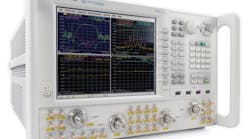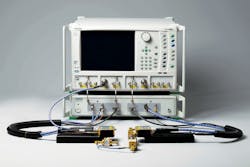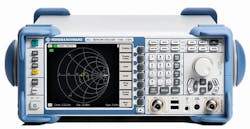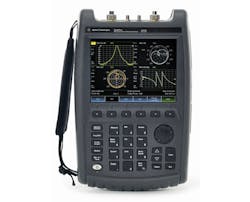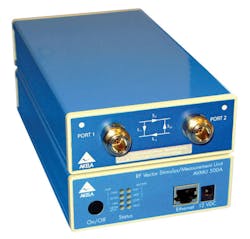High-frequency measurements serve many purposes: not only to verify that an electronic component, device, or system achieves its target performance goals, but also to gather information to create software models that can be used to design the next-generation product. Among the most valuable of RF/microwave test tools is the vector network analyzer (VNA), which can measure amplitude and phase with frequency.
Related Articles
• Balanced Amplifier Aims For Low Noise
• Sequential Rotation Feeds Microstrip Array
• Sampling An Array Of Test Probes And Fixtures
VNAs have long become associated with the measurements of complex impedance parameters—such as scattering (S) parameters—using the test data to design efficient impedance matching networks for the optimum transmission of high-frequency signals through active and passive devices and networks. At present, VNAs are available from both well-known and not-so-well-known instrument manufacturers, in both bench top and portable configurations for making measurements on high-frequency (HF) through millimeter-wave-frequency signals.
As with many RF/microwave test instruments, commercial VNAs are moving higher in frequency to support a growing number of millimeter-wave applications; these include high-data-rate, short-range line-of-sight communications systems and automotive collision-avoidance radar systems. Many of the major bench top VNA suppliers—including Agilent Technologies, Anritsu Co., and Rohde & Schwarz—offer VNA measurement systems with top frequencies to 50 and 67 GHz, using either coaxial or waveguide test ports, and many deliver frequency coverage past 100 GHz with waveguide test ports.
Obviously, VNAs are complex instruments. Specifying a unit for different applications (or even trying to compare different models from different suppliers) can be challenging. Perhaps the easiest way to characterize different VNAs is to remember that they are based on sensitive measurement receivers with dedicated precision broadband test sources. The parameters used to evaluate receivers (like frequency and dynamic range) and to compare test sources (e.g., test signal power, harmonics, spurious content, and phase noise) can also be applied to VNAs when comparing different models.
A parameter such as VNA measurement speed will depend on a number of factors, including IF bandwidth, the width of the measurement sweep, the switching speed of the test source, and the number of measurement points in a sweep. Narrow IF bandwidths (such as 10 Hz) require longer measurement times than wider IF bandwidths, although the narrower IF filter bandwidths minimize noise and help reveal fine details in a captured signal trace.
1. The PNA-X high-performance line of VNAs feature accurate measurement capabilities through millimeter-wave frequencies. (Photo courtesy of Agilent Technologies.)
Agilent Technologies offers its PNA series of VNAs not only in different frequency ranges, but with different performance levels in its PNA-L, PNA, and PNA-X product families (Fig. 1). Specifiers can balance cost with measurement quality when matching a two- or four-port VNA model to a set of test applications. For example, providing high-quality measurements for sensitive budgets, model N5235A is a two-port PNA-L analyzer with frequency range from 10 MHz to 50 GHz that shows results on a bright 1024 x 768 pixel front-panel, color liquid-crystal-display (LCD) screen. It includes 2.4-mm coaxial connectors on the test ports and BNC female connectors. These provide access to the VNA’s own 10-MHz reference source, or else feed an outside 10-MHz reference source to the N5235A VNA for improved measurement stability (assuming that the external reference is superior to the internal 10-MHz reference source of the N5235A).
A model N5235A PNA-L VNA provides typical two-port receive dynamic range of 100 dB from 10 to 45 MHz, 120 dB or better from 45 MHz through 13.5 GHz, and 103 dB or better from 13.5 through 50.0 GHz. It delivers maximum leveled test port power to 0 dBm through 20 GHz, -5 dBm through 40 GHz, and -11 dBm through 50 GHz, with power level linearity of ±2 dB from 10 to 45 MHz and ±1.5 dB from 45 MHz to 50 GHz. Test signal second and third harmonics are typically -20 dBc or better though 50 GHz, while spurious levels are typically -45 dBc or better through 18 GHz and -33 dBc or better through 50 GHz. The test-signal phase noise is typically -87 dBc/Hz offset 10 kHz for carriers through 18 GHz and typically -75 dBc/Hz offset 10 kHz for carriers through 50 GHz. When higher-performance levels are needed, the firm’s PNA and PNA-X lines of VNAs provide improved performance levels through millimeter-wave frequencies, at somewhat elevated prices.
The VectorStar® family of bench top VNAs from Anritsu Co. includes the MS4640A line of instrument systems with broad frequency coverage of 70 kHz to 70 GHz (Fig. 2), as well as the ME7838A Series of VNAs with a range from 70 kHz to 110 GHz based on a 1-mm coaxial test port connector. The MS4640A series combines -80 dBm test-signal measurement sensitivity combined with a measurement speed of 20 μs/point and 100-dB dynamic range at 70 GHz.
2. The VectorStar family of VNAs includes a version capable of frequency coverage from 70 kHz to 70 GHz. (Photo courtesy of Anritsu Co.)
The Anritsu VNAs are based on an Open Windows software architecture for reliable measurement speed and versatile connectivity. The MS4640A system also offers numerous options—including Option 041, which provides the added capability to perform noise-figure measurements in addition to characterizing the four S-parameters of a device under test (DUT). When equipped with a frequency extension and optimized noise receiver, an MS4640A VNA can perform noise measurements on DUTs from 70 kHz to frequencies as high as 125 GHz as needed.
Another well-known bench top VNA supplier, Rohde & Schwarz, offers its high-performance R&S® ZVA analyzers for measurements through 67 GHz. The R&S® ZVA analyzers include model R&S ZVA8 for measurements from 10 MHz to 8 GHz, model R&S ZVA40 for use from 10 MHz to 40 GHz, model R&S ZVA50 spanning 10 MHz to 50 GHz, and model R&S ZVA67 covering 10 MHz to 67 GHz. The instruments respectively achieve measurement dynamic ranges of better than 120 dB to 8 GHz, better than 118 dB to 40 GHz, better than 110 dB to 50 GHz, and better than 105 dB to 67 GHz. In fact, model R&S ZVA67 is usable to 70 GHz and provides a typical dynamic range of 103 dB at 70 GHz.
The firm also supports a growing demand for portable RF/microwave VNAs with its R&S ZVL portable VNAs, with models available through 13.6 GHz (Fig. 3). The R&S ZVL portable line includes model R&S ZVL3 with frequency range of 9 kHz to 3 GHz, model R&S ZVL6 with a frequency range of 9 kHz to 6 GHz, and model R&S ZVL13 with a frequency range of 9 kHz to 13.6 GHz. All of these portable VNAs offer measurement bandwidths of 10 Hz to 500 kHz, frequency resolution as good as 1 Hz, and as many as 4001 measurement points. The R&S ZVA instruments achieve better than 115-dB dynamic range to 3 GHz, better than 110-dB dynamic range to 6 GHz, and better than 95-dB dynamic range to 13.6 GHz.
3. The R&S® ZVL line of portable VNAs includes models operating as high as 13.6 GHz. (Photo courtesy of Rohde & Schwarz.)
A growing number of portable VNAs are available from other instrument suppliers, including the FieldFox portable VNAs (Fig. 4) from Agilent Technologies, and the VNA Master portable VNAs from Anritsu Co. For example, the two-port model MS2028C VNA Master operates from 5 kHz to 20 GHz and can measure all four S-parameters with a single connection.
4. The FieldFox line of VNAs is representative of a growing trend in precision VNA measurement capabilities in portable, battery-powered packages. (Photo courtesy of Agilent Technologies.)
For those seeking compact VNA measurement solutions, National Instruments offers a startup kit based on their model PXIe-5630 PXI-based modular VNA. The kit includes all additional components needed for amplitude and phase measurements from 10 MHz to 6 GHz. The two-port VNA supports IF bandwidths from 10 Hz to 500 kHz and as many as 200,001 measurement points. The firm’s model PXI-5632 features a three-slot PXI Express form factor but with extended frequency range from 300 kHz to 8.5 GHz. Both analyzers employ a dual-source architecture with independent tuning of frequency and test source power in support of a 110-dB dynamic range; both work with the company’s NI LabVIEW and NI LabWindows™/CVI test and measurement software to simplify complex measurements.
5. This compact VNA module operates from 1 kHz to 1.3 GHz with a dynamic range of better than 50 dB. (Photo courtesy of SDR-Kits.)
In recent years, numerous other companies have developed practical VNA test solutions, including Copper Mountain Technology with its PLANAR 804/1 VNA system and SDR-Kits with its model DG8SAQ 1.3-GHz VNA module (Fig. 5). The PLANAR 804/1 VNA is part of Copper Mountain Technologies’ Virtual Vector Network Analyzers line. It measures all four S-parameters over a frequency range of 300 kHz to 8 GHz with 145-dB dynamic range and 100μs switching speed per point. The unit has a test output power adjustment range of -60 to +10 dBm and can make as many as 500,001 measurement points per sweep. The model DG8SAQ VNA module from SDR-Kits operates from 1 kHz to 1.3 GHz with a dynamic range of 90 dB to 500 MHz, and better than 50 dB above 500 MHz. It is powered by a computer’s USB port.
6. This VNA module operates from 250 MHz to 2 GHz and connects to a computer with a RJ-45 Ethernet cable. (Photo courtesy of Akela, Inc.)
In addition, Akela now offers a computer-driven module capable of two-port VNA measurements from 250 MHz to 2 GHz (Fig. 6). It connects to a personal computer by means of its RJ-45 Ethernet port and operates under the control of LabView test software from National Instruments. The module, which provides a 60-dB dynamic range, can be set up by simply installing the software, connecting the module to the computer by means of regular Ethernet cable, and powering up the module.
